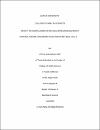EFFECT OF ENDOPLASMIC RETICULUM STRESS MEDIATED BY HYPERGLYCEMIA ON BARRIER FUNCTION IN RETINAL CELLS
Abstract
Background: Diabetic Retinopathy (DR) is an inflammatory disease mainly characterized by the dysfunction of the retinal blood vessels. Several studies reported a possible link between the hyperglycemia and the activation of unfolded protein response (UPR) and hence initiating endoplasmic reticulum (ER) stress in various retinal cells. However, the mechanism underlying the ER stress in the human retinal endothelial cells (HRMEC) remains poorly investigated and understood.
Methodology: In the present study, utilizing the HRMEC, we evaluated the effect of high glucose (30mM) on several ER stress signaling pathway genes (HSPA5, EIF2K3, and XBP1) at the mRNA expression level; the inflammatory cytokines (NFkB) at the mRNA level; the adhesion molecules (ICAM-1 and P-selectin) by flow cytometry. In addition we assessed the barrier function of HRMEC on real-time analysis using the electric-cell substrate impedance (ECIS). Also, this study uses the Tunicamycin (TM) as positive stress inducer and Phenyl-butyric acid (PBA) as an ER stress inhibitor and study their effects on the treatment groups.
Results: We found that hyperglycemia increases the cellular production of reactive oxygen species (ROS) and PBA decreasing it. Also the barrier quality of HRMEC was affected significantly with treatment of high glucose and improved with PBA. The expression of Adhesion proteins (ICAM-1 and E-selectin) were increased in hyperglycemia and decreased expression with PBA.
Conclusion: Our results suggest that hyperglycemia may activate ER stress that could play a role in the angiogenesis in the diabetic retinopathy.
DOI/handle
http://hdl.handle.net/10576/5083Collections
- Biomedical Sciences [69 items ]


